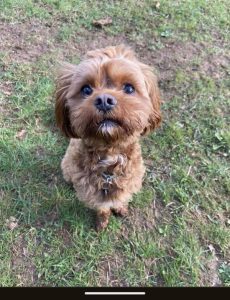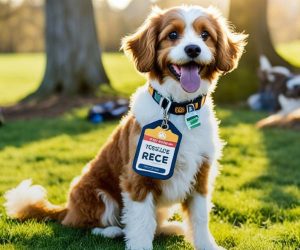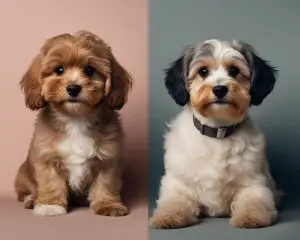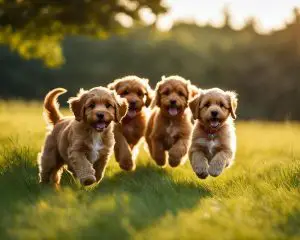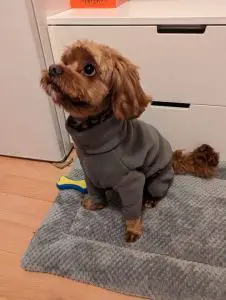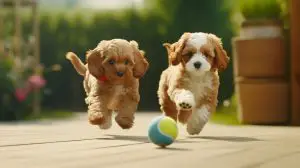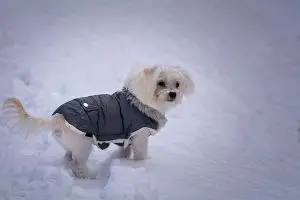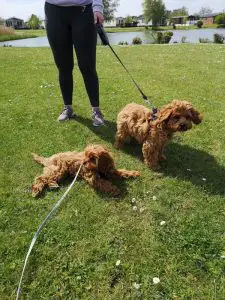As a Cavapoo owner, you may wonder whether your furry friend can handle alone time. Understanding your pet's needs is crucial to ensure their well-being and happiness.
Cavapoos are known for their affectionate and loyal nature, which means they thrive on human companionship. However, they're also adaptable and can adjust to periods of alone time if adequately prepared.

Table of Contents
- How Long Can a Cavapoo Be Left Alone?
- Leaving a Cavapoo at Home: Ensuring their Well-being
- Cavapoo Crate Training: A Helpful Tool for Alone Time
- Understanding Cavapoo Exercise Needs to Prevent Behavioral Issues
- General Cavapoo Care Tips for Alone Time and Beyond
- FAQ: Can Cavapoo be Left Alone?
How Long Can a Cavapoo Be Left Alone?
As a loving pet owner, it's natural to want to spend as much time as possible with your furry friend. However, there may be times when you need to leave your Cavapoo alone. The good news is that, with proper training and consideration for their needs, Cavapoos can handle being alone for moderate periods.
Despite their small size, Cavapoos are an active breed who require plenty of exercise and mental stimulation. Leaving them alone for prolonged periods can lead to boredom, anxiety, and undesirable behaviours such as excessive barking, destructive chewing, or house soiling. It's essential to understand your Cavapoo's individual temperament and adjust your time away accordingly.
How Long Is Too Long?
So, how long can a Cavapoo be left alone? There's no definitive answer as it depends on several factors, such as age, activity level, and overall health. However, as a general guideline, adult Cavapoos can comfortably be left alone for up to six hours a day. Puppies, on the other hand, have a shorter attention span, and their potty training may require more frequent breaks, so they should not be left alone for more than two to three hours at a time.
It's also worth considering your own schedule and lifestyle when planning your Cavapoo's alone time. If you work long hours or have frequent social engagements, it may be beneficial to consider a dog walker or doggy daycare service to break up their day and provide socialization opportunities.
Addressing Separation Anxiety
Separation anxiety is a common issue among dogs, and Cavapoos are no exception. If your Cavapoo shows signs of excessive barking, pacing, or destructive behavior when left alone, it may be due to separation anxiety. In this case, it's essential to address the root cause of the anxiety rather than simply increasing their alone time gradually.
You can work with a trainer or veterinarian to develop a behavior modification plan, which may include positive reinforcement training, crate training, or anti-anxiety medication. By taking action early on, you can prevent separation anxiety from becoming a severe and persistent issue.
Leaving a Cavapoo at Home: Ensuring their Well-being
Leaving your Cavapoo at home can be a daunting experience, but with the right preparation, you can set them up for success.
Creating a comfortable and safe environment for your Cavapoo while you're away is crucial. It's important to ensure they have access to fresh water and a comfortable bed or crate, depending on what they prefer. Consider leaving soft toys or interactive puzzles to keep them engaged and entertained.
Establishing a routine can also help your Cavapoo feel secure during alone time. Try to stick to a consistent schedule for feeding and exercise, and provide opportunities for them to go potty before you leave.
If your Cavapoo experiences separation anxiety, it may be helpful to leave an item with your scent on it, such as a piece of clothing or blanket. Additionally, playing calming music or leaving a TV on can provide comforting background noise.
Remember to keep an eye on your Cavapoo's behaviour and body language when you return home. If they seem particularly anxious or distressed, it may be worth seeking advice from a professional trainer or behaviourist.
Cavapoo Crate Training: A Helpful Tool for Alone Time
Crate training can be a useful tool when it comes to helping your Cavapoo feel secure during alone time. It also provides them with a positive space where they can relax and rest. Here are some advantages of crate training your Cavapoo:
- It can assist with potty training during their early months
- It can help them feel secure and at ease during travel
- It can be a helpful solution when they're overly stimulated or nervous
- It can prevent them from getting into unsafe situations when left alone
Introducing your Cavapoo to a crate should be a gradual process to avoid overwhelming them. Here are some steps to follow:
- Choose the right size crate for your Cavapoo. The crate should be large enough for them to stand up, turn around, and lay down comfortably.
- Place their favorite blanket or toy inside the crate to make it more appealing.
- Encourage them to explore the crate on their own. Offer treats inside the crate or feed them meals near the crate. Let them become comfortable with the crate at their own pace.
- Slowly increase the amount of time they spend inside the crate. Start with just a few minutes and gradually work your way up to longer periods of time.
It's essential to make sure your Cavapoo doesn't feel trapped or isolated in the crate. Make it a positive experience by offering treats and verbal praise when they go inside. Avoid using the crate as a form of punishment, and never leave them inside for extended periods of time.
Understanding Cavapoo Exercise Needs to Prevent Behavioral Issues
As with any dog breed, regular exercise is essential for maintaining a healthy lifestyle for your Cavapoo. But did you know that exercising your Cavapoo can also help prevent behavioral issues?
Cavapoos are an active breed, and they require both physical activity and mental stimulation to keep them happy and healthy. Aim for at least 30 to 60 minutes of exercise each day, depending on your Cavapoo's age, size, and energy level. This exercise can take the form of brisk walks or off-leash playtime in a securely fenced area.
However, it's not just physical activity that Cavapoos need. Mental stimulation is also essential for preventing boredom and destructive behavior. Interactive toys, puzzle feeders, and obedience training can all provide the mental stimulation that your Cavapoo craves.
If your Cavapoo is exhibiting behavioral issues such as excessive barking, destructive chewing, or hyperactivity, it could be a sign that they are not receiving adequate exercise. Be sure to consult with your veterinarian or a professional dog trainer to address any behavioral concerns that you may have.
Fulfilling Your Cavapoo's Exercise Needs
Here are some tips for fulfilling your Cavapoo's exercise needs:
- Take your Cavapoo for daily walks or runs
- Provide mental stimulation through interactive toys and puzzle feeders
- Enroll your Cavapoo in obedience or agility training
- Play off-leash in a securely fenced area
Remember, a well-exercised and mentally stimulated Cavapoo is a happy and well-behaved dog. By providing your Cavapoo with adequate exercise and stimulation, you can prevent behavioral issues and maintain a healthy and loving relationship with your furry companion.
General Cavapoo Care Tips for Alone Time and Beyond
While understanding and addressing your Cavapoo’s alone time needs is important, it’s equally crucial to consider their overall well-being. Here are some general care tips to help keep your Cavapoo healthy and happy.
Grooming
Cavapoos require regular grooming to maintain healthy skin and a shiny coat. Brush their coat daily to remove any tangles, and trim their hair every 6-8 weeks to prevent matting. Bathe them once every 4-8 weeks, or as needed, using a gentle dog shampoo.
Feeding
Provide your Cavapoo with a balanced diet that supplies all their nutritional needs. Feed them high-quality dog food suited for their size and age, and avoid giving them table scraps or human food. Make sure they have access to fresh water at all times.
Socialization
Cavapoos are social and affectionate dogs that crave human and canine interaction. Socialize them early on with a variety of people and other dogs to help them develop positive behaviours. Enroll them in puppy classes and provide them with plenty of opportunities to socialize with other dogs.
Veterinary Check-ups
Regular veterinary check-ups are important to ensure that your Cavapoo is happy and healthy. Schedule annual check-ups, and make sure your Cavapoo is up to date with their vaccinations and other preventive treatments.
Routine
Establish a consistent routine for your Cavapoo, including regular feeding times, exercise, and alone time. This will help them feel secure and confident in their environment. By sticking to a routine, they will know what to expect and when, reducing stress and anxiety.
FAQ: Can Cavapoo be Left Alone?
Leaving your Cavapoo alone for extended periods can be a cause for concern among pet owners. Here are some of the most frequently asked questions about leaving Cavapoos alone:
How long can a Cavapoo be left alone?
The length of time that a Cavapoo can be left alone varies depending on age, temperament, and individual needs. As a general rule, puppies should not be left alone for more than two hours, while adult Cavapoos can typically handle up to six hours of alone time. However, it's essential to monitor your pet's behaviour and adjust their alone time accordingly.
What are the signs of separation anxiety in a Cavapoo?
Separation anxiety can manifest in several ways, including destructive behaviour, excessive barking or whining, and toileting in inappropriate areas. If your Cavapoo exhibits any of these symptoms, there may be underlying anxiety issues that require attention and addressing.
How can I prevent my Cavapoo from experiencing separation anxiety?
Gradually acclimating your Cavapoo to alone time, providing ample exercise and mental stimulation, and establishing a routine can all help prevent separation anxiety. Crating can also be an effective tool for providing your Cavapoo with a safe and comfortable space during alone time.
What can I do if my Cavapoo experiences separation anxiety?
If your Cavapoo experiences separation anxiety, you should seek professional advice from a veterinarian or animal behaviourist. They may recommend techniques such as counterconditioning, medication, or a behaviour modification plan to address the underlying causes of the anxiety.
By taking steps to understand your Cavapoo's needs and providing them with the appropriate care, you can help ensure their happiness and well-being during alone time and beyond.
Read the latest Cavapoo posts here:
- Golden Cavapoo Guide: Care, Training & TipsAs a devoted dog lover, I can't help but feel a sense of joy and fulfillment whenever I see a wagging tail and a pair of eager eyes looking up at me. Dogs have this incredible ability to bring light, love, and companionship into our lives, and one particular breed that has stolen my heart… Read more: Golden Cavapoo Guide: Care, Training & Tips
- Adopt a Rescue Cavapoo Today – Find Your Buddy!Imagine coming home to a wagging tail, a warm snuggle buddy, and unconditional love. That's the joy of having a furry friend by your side. But what if I told you that you could not only experience the purest form of companionship but also change a life in the process? By adopting a rescue cavapoo,… Read more: Adopt a Rescue Cavapoo Today – Find Your Buddy!
- Black Cavapoo Puppies: Your Adorable GuideImagine coming home to a furry ball of excitement, wagging its tail and eagerly waiting for your return. Picture the joy of cuddling up on the sofa with a playful companion who brings laughter and warmth to your life. This is the magic that black Cavapoo puppies can bring to your world. Whether you're a… Read more: Black Cavapoo Puppies: Your Adorable Guide
- Straight Hair Cavapoo Traits and Care GuideHave you ever dreamed of having a furry companion who is not only adorable but also hypoallergenic? Someone who will bring joy and love into your life without triggering pesky allergies or leaving a trail of fur behind? Well, let me introduce you to the straight hair Cavapoo, the perfect blend of cuteness and allergy-friendly… Read more: Straight Hair Cavapoo Traits and Care Guide
- Best brush for a CavapooWhen you first bring your adorable little Cavapoo home, you’ll still be gathering all the things you need to take the best care of him or her. This post has been updated on 27th Feb 2024. One of the best brushes I’ve found is the Big G Slicker Brush by Chris Christensen. The longer pins… Read more: Best brush for a Cavapoo
- Meet the Unique Cavapoo with Blue Eyes - A Rare BeautyAs a professional journalist, I've had the pleasure of writing about various dog breeds, but the Cavapoo with blue eyes stands out as a true rarity. This captivating canine boasts striking blue eyes that add to its already unique charm. The Cavapoo breed with blue eyes is a sight to behold, with a playful personality… Read more: Meet the Unique Cavapoo with Blue Eyes - A Rare Beauty
- Comparing Breeds: Poochon vs Cavapoo - A Detailed InsightWhen it comes to selecting a new pet, many people find themselves deciding between the Poochon and Cavapoo breeds. While both are popular for their hypoallergenic qualities and suitability as family pets, there are distinct differences between the two that potential owners should consider. In this article, we will provide a detailed comparison of the… Read more: Comparing Breeds: Poochon vs Cavapoo - A Detailed Insight
- Adorable Newborn Cavapoo Puppies: A Must-Have CompanionGreetings! As a professional copywriting journalist, I am delighted to explore with you the irresistible charm of newborn Cavapoo puppies in this article. If you're a dog lover looking for a furry friend, you'll want to know how Cavapoo puppies make the perfect companions. Let's discover the joys of welcoming these adorable little bundles of… Read more: Adorable Newborn Cavapoo Puppies: A Must-Have Companion
- Meet the Adorable Ginger Cavapoo: Your Perfect CompanionIf you are in search of the ultimate companion that is both affectionate and adaptive, look no further than the ginger Cavapoo. These charming little dogs are a crossbreed between a Cavalier King Charles Spaniel and a Poodle, resulting in a lovable combination of traits that make them the perfect addition to any family. One… Read more: Meet the Adorable Ginger Cavapoo: Your Perfect Companion
- Your Guide to Adorable Ruby Cavapoo PuppiesWelcome to my comprehensive guide on ruby Cavapoo puppies! As a professional copywriting journalist, I have extensive experience researching and writing about different dog breeds. In this guide, we will explore everything you need to know about the adorable ruby Cavapoo, including their breed information, care tips, and why they make a perfect addition to… Read more: Your Guide to Adorable Ruby Cavapoo Puppies
- Overcoming Challenges: Why I Hate My Cavapoo & How To Love ItAs a Cavapoo owner, I know firsthand the challenges and frustrations that come with having this adorable breed as a furry companion. Despite their cute appearance and affectionate nature, Cavapoos can sometimes exhibit problem behaviors that lead to feelings of dislike and even resentment towards them. If you've ever found yourself saying "I hate my… Read more: Overcoming Challenges: Why I Hate My Cavapoo & How To Love It
- Unbiased Jonas Cavapoo Puppies Reviews: Happy Pet Parents Speak OutWhy Cavapoo Puppies are Highly Sought After As a professional copywriting journalist, I have had the opportunity to interact with many dog breeds. However, Cavapoos stand out as one of the most sought after breeds. But why? Cavapoo puppies are a perfect blend of the adorable, fun-loving, and affectionate attributes of a Cavalier King Charles… Read more: Unbiased Jonas Cavapoo Puppies Reviews: Happy Pet Parents Speak Out
- Explore Adorable River's Edge Cavapoos: Your Perfect Family PetAre you looking for a furry companion to bring joy and love into your family? If you're based in the US then you could take a look at River's Edge Cavapoos. Cavapoos are adorable puppies which are the perfect mix of Cavalier King Charles Spaniel and Poodle, resulting in a loving and gentle temperament that… Read more: Explore Adorable River's Edge Cavapoos: Your Perfect Family Pet
- Unveiling the Timeline: How Long for Cavapoo Hair to Grow BackAs a professional copywriting journalist, I often come across concerned Cavapoo owners wondering how long it will take for their pet's hair to regrow. The answer is not straightforward since several factors come into play in determining the time it takes for Cavapoo hair growth. In this section, I will explore the timeline for Cavapoo… Read more: Unveiling the Timeline: How Long for Cavapoo Hair to Grow Back
- Enjoy Comfort & Warmth with Equafleece Cavapoo Sweaters!As the temperature drops, it's essential to keep our furry friends warm and comfortable. The Equafleece Cavapoo Sweaters are a perfect solution to keep your Cavapoo cozy during the winter months. Equafleece is a renowned brand that offers high-quality dog fleece, including customized clothing for specific breeds, shapes and sizes, including our beloved Cavapoos. Equafleece… Read more: Enjoy Comfort & Warmth with Equafleece Cavapoo Sweaters!
- Understanding the Lifespan: How Long Will a Cavapoo Live?Welcome to our informative guide on the lifespan of a Cavapoo. As a loving pet owner, you want to ensure that your furry friend has the best possible quality of life. Knowing how long your Cavapoo is likely to live is an essential aspect of planning for their long-term care. In this section, we will… Read more: Understanding the Lifespan: How Long Will a Cavapoo Live?
- Essential Guide: What Should I Know Before Buying a Cavapoo?Are you considering bringing a Cavapoo into your home? These adorable pups are a popular mix of Cavalier King Charles Spaniel and Poodle, but before making a purchase, there are some essential things you should know. First and foremost, it's important to understand the care requirements, including grooming routines, nutrition needs, and exercise requirements. Additionally,… Read more: Essential Guide: What Should I Know Before Buying a Cavapoo?
- Is a Male or Female Cavapoo Better? Discover the Answer!Are you considering adding a Cavapoo to your family but unsure which gender to choose? Don't worry; you're not alone. Many potential pet owners find themselves asking the question, "Is a male or female Cavapoo better?" Fortunately, we're here to help you discover the answer. Before we dive into gender-specific characteristics, let's first understand the… Read more: Is a Male or Female Cavapoo Better? Discover the Answer!
- Can Cavapoo be Left Alone? Understanding Your Pet's Needs.As a Cavapoo owner, you may wonder whether your furry friend can handle alone time. Understanding your pet's needs is crucial to ensure their well-being and happiness. Cavapoos are known for their affectionate and loyal nature, which means they thrive on human companionship. However, they're also adaptable and can adjust to periods of alone time… Read more: Can Cavapoo be Left Alone? Understanding Your Pet's Needs.
- Does a Cavapoo Smell? Decoding Your Pup's Unique ScentAs a Cavapoo owner, you know that these adorable pups are a joy to be around. However, you may have noticed a unique scent emanating from your furry friend. But does a Cavapoo smell? The answer is yes, just like any other dog breed, Cavapoos have an odour. But don't worry, there are ways to… Read more: Does a Cavapoo Smell? Decoding Your Pup's Unique Scent
- Addressing Cavapoos Problems: What You Should KnowWelcome to our guide on Cavapoos! These adorable furry companions are known for their friendly and loving nature, but just like any other breed, they may encounter certain problems. In this section, we will discuss the common problems faced by Cavapoos, including their health issues and other challenges. It is important for prospective and current… Read more: Addressing Cavapoos Problems: What You Should Know
- Decoding the Price: How Much Should a Cavapoo Cost?Are you considering adding a Cavapoo to your family but unsure about the cost? We understand that the pricing of Cavapoos can vary greatly, making it challenging to determine what you should be paying. In this article, we'll explore the various factors that affect the cost of a Cavapoo, including health checks, pedigree, and breeder… Read more: Decoding the Price: How Much Should a Cavapoo Cost?
- Cavapoo vs Cockapoo: What's Better? Explore Your Pup Choice!Choosing a furry friend to join your family can be a challenging decision, especially when it comes to the popular Cavapoo and Cockapoo breeds. Both are a combination of two adorable purebreds, making them highly sought after for their charming looks and loving personalities. If you're wondering "what's better Cavapoo or cockapoo," you're not alone.… Read more: Cavapoo vs Cockapoo: What's Better? Explore Your Pup Choice!
- Uncovering the Truth: Are Cavapoos Good Temperament Dogs?Welcome to our guide on Cavapoo temperament! If you're considering getting a Cavapoo, or just curious about their temperament, you've come to the right place. In this article, we'll explore the personality and behaviour of this adorable breed. Many people wonder, "Are Cavapoos good temperament dogs?" The answer is a resounding yes! Cavapoos are known… Read more: Uncovering the Truth: Are Cavapoos Good Temperament Dogs?
- Do Cavapoos Bark a Lot? Your Guide to Understanding Cavapoo BehaviorAre you considering getting a Cavapoo or already own one? One of the most common questions asked about these adorable pups is: do Cavapoos bark a lot? Cavapoos can be moderately vocal, their tendency to bark depends on their individual personality. Early training will certainly help manage excessive barking. As with any dog breed, Cavapoos… Read more: Do Cavapoos Bark a Lot? Your Guide to Understanding Cavapoo Behavior
- Unveiling the Truth: Do Cavapoos Make Good Pets?Yes, Cavapoos make good pets. They're known for their friendly and sociable nature. They are a crossbreed of Cavalier King Charles Spaniel and Poodle, combining the affectionate nature of the former with the intelligence of the latter. Obviously my opinion may well be biased as I absolutely love my Cavapoo, he's called Bean. That said… Read more: Unveiling the Truth: Do Cavapoos Make Good Pets?
- Merle CavapooDiscover the enchanting Merle Cavapoo, a delightful crossbreed with a splash of colour. Unleash joy and beauty with this charming companion. Find out more now! Key Takeaways: Merle Cavapoo Introduction The Merle Cavapoo is a highly sought-after breed that combines the intelligence of the Poodle with the affectionate nature of the Cavalier King Charles Spaniel.… Read more: Merle Cavapoo
- Cavapoo UnderbiteExplore the causes and solutions for underbites in Cavapoos. Learn how to care for your pet's dental health and ensure their long-term wellbeing. The posh word for "Underbite" is "Malocclusion" but I always try to use simple plain language in my blog posts whenever possible. If you read through this I'm confident you'll have a… Read more: Cavapoo Underbite
- Does my Cavapoo need a winter coat?Cavapoos can feel the cold. You might want to think about buying him/her a coat to keep warm and provide a little extra protection against the weather. Several coats are water/windproof and cover most of the body, to trap in heat and keep them warm. Unsure what coat to go for, or whether your dog… Read more: Does my Cavapoo need a winter coat?
- Are Cavapoos Good with Kids?Cavapoos are great with kids. Cavapoos live to have fun, making them perfect playmates for kids, especially those 6 years and over. They enjoy getting involved in dog sports and activities and are great at playing fetch and chasing balls. They love spending time with people and are unfailingly loyal. In the rest of this… Read more: Are Cavapoos Good with Kids?
- Do Cavapoos Get on Well with Cats?Yes, they do. Cavapoos adore the company of other animals — even cats! Their playful nature makes them great companions for your feline friends. Cavapoos are happy go lucky and will be happy to play for as long as your cat permits. You should supervise them the first time they are together though. You can… Read more: Do Cavapoos Get on Well with Cats?
- Are Cavapoos Prone to Separation Anxiety?It is common for Cavapoos to suffer from separation anxiety. This is because they are loving and affectionate dogs, they love being with their owners and are happy doing anything if their owner is nearby. We’ll discuss separation anxiety in the rest of this piece and share tips on how to help your puppy and… Read more: Are Cavapoos Prone to Separation Anxiety?
- How much exercise does a Cavapoo need?Cavapoos are gorgeous little high-energy dogs that are becoming ever more popular thanks to their lively dispositions, sociability, and great temperaments. You’ll want to make sure your furry friend gets lots of stimulation and exercise so that they don’t become cute little energy-filled home wreckers. A fully-grown, healthy Cavapoo needs a minimum of 40 minutes… Read more: How much exercise does a Cavapoo need?
- Are Cavapoos easy to potty train?When you first pick up your new Cavapoo puppy it’s an absolute delight, and the fun and love they’ll give you is immense. However, if they’re not house trained in a timely manner it can start to be a problem. Potty training a Cavapoo puppy can be challenging, but because they are one of the… Read more: Are Cavapoos easy to potty train?

